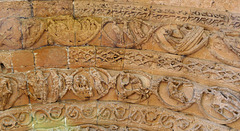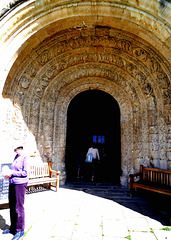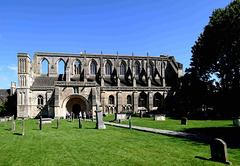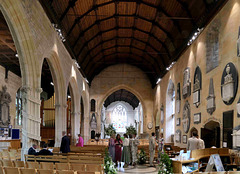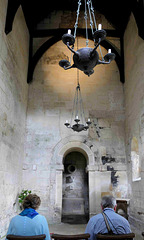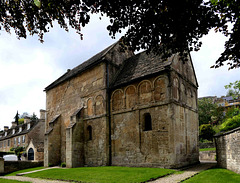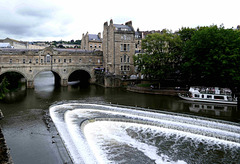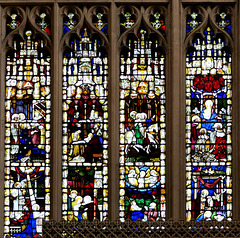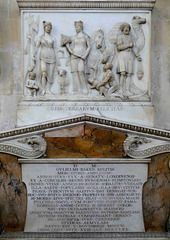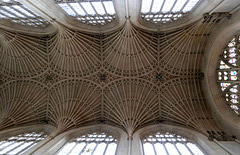Martin M. Miles' photos
Malmesbury - Abbey
| |
|
|
|
Malmesbury, the oldest borough in England, became the site of Malmesbury Abbey, a monastery famed for its learning. It was later home to one of Alfred the Great's fortified castles (burhs) for defence against the Vikings. As a market town, it became prominent in the Middle Ages as a centre for learning, focused on and around the abbey.
In the later seventh century, the site of the Abbey was chosen by Máel Dub, an Irish monk who established a hermitage. Towards the end of his life Malmesbury Abbey was founded around 676 by Aldhelm, a nephew of King Ine of Wessex. The town of Malmesbury grew up around the expanding Abbey.
In October 939 Æthelstan, king of Wessex and of the English, died in Gloucester, and in the year 941 his remains were buried in the Abbey.
The Abbey developed an illustrious reputation for academic learning under the rule of abbots such as Aldhelm, John Scotus Eriugena, Alfred of Malmesbury and Aelfric of Eynsham.
The current Abbey was substantially completed by 1180. The 131 m tall spire, and the tower it was built upon, collapsed around 1500 destroying much of the church, including two-thirds of the nave and the transept.
The abbey was closed at the Dissolution of the Monasteries in 1539 by Henry VIII and was sold to William Stumpe, a rich merchant. He returned the abbey church to the town for continuing use as a parish church, and filled the abbey buildings with up to 20 looms for his cloth-weaving enterprise.
During the English Civil War, Malmesbury suffered extensive damage evidenced by hundreds of pock-marks left by bullets.
Cluny did strongly influence the artistic style here. The connection to Cluny was close. Abbot Peter Moraunt had been a monk of Cluny and had been for a time Prior of La Charité.
Unfortunately the carvings of the portal are very weathered. Seen here may be Noah's Ark
Malmesbury - Abbey
| |
|
|
Malmesbury, the oldest borough in England, became the site of Malmesbury Abbey, a monastery famed for its learning. It was later home to one of Alfred the Great's fortified castles (burhs) for defence against the Vikings. As a market town, it became prominent in the Middle Ages as a centre for learning, focused on and around the abbey.
In the later seventh century, the site of the Abbey was chosen by Máel Dub, an Irish monk who established a hermitage. Towards the end of his life Malmesbury Abbey was founded around 676 by Aldhelm, a nephew of King Ine of Wessex. The town of Malmesbury grew up around the expanding Abbey.
In October 939 Æthelstan, king of Wessex and of the English, died in Gloucester, and in the year 941 his remains were buried in the Abbey.
The Abbey developed an illustrious reputation for academic learning under the rule of abbots such as Aldhelm, John Scotus Eriugena, Alfred of Malmesbury and Aelfric of Eynsham.
The current Abbey was substantially completed by 1180. The 131 m tall spire, and the tower it was built upon, collapsed around 1500 destroying much of the church, including two-thirds of the nave and the transept.
The abbey was closed at the Dissolution of the Monasteries in 1539 by Henry VIII and was sold to William Stumpe, a rich merchant. He returned the abbey church to the town for continuing use as a parish church, and filled the abbey buildings with up to 20 looms for his cloth-weaving enterprise.
During the English Civil War, Malmesbury suffered extensive damage evidenced by hundreds of pock-marks left by bullets.
Cluny did strongly influence the artistic style here. The connection to Cluny was close. Abbot Peter Moraunt had been a monk of Cluny and had been for a time Prior of La Charité.
Unfortunately the carvings of the portal are very weathered
Malmesbury - Abbey
| |
|
|
Malmesbury, the oldest borough in England, became the site of Malmesbury Abbey, a monastery famed for its learning. It was later home to one of Alfred the Great's fortified castles (burhs) for defence against the Vikings. As a market town, it became prominent in the Middle Ages as a centre for learning, focused on and around the abbey.
In the later seventh century, the site of the Abbey was chosen by Máel Dub, an Irish monk who established a hermitage. Towards the end of his life Malmesbury Abbey was founded around 676 by Aldhelm, a nephew of King Ine of Wessex. The town of Malmesbury grew up around the expanding Abbey.
In October 939 Æthelstan, king of Wessex and of the English, died in Gloucester, and in the year 941 his remains were buried in the Abbey.
The Abbey developed an illustrious reputation for academic learning under the rule of abbots such as Aldhelm, John Scotus Eriugena, Alfred of Malmesbury and Aelfric of Eynsham.
The current Abbey was substantially completed by 1180. The 131 m tall spire, and the tower it was built upon, collapsed around 1500 destroying much of the church, including two-thirds of the nave and the transept.
The abbey was closed at the Dissolution of the Monasteries in 1539 by Henry VIII and was sold to William Stumpe, a rich merchant. He returned the abbey church to the town for continuing use as a parish church, and filled the abbey buildings with up to 20 looms for his cloth-weaving enterprise.
During the English Civil War, Malmesbury suffered extensive damage evidenced by hundreds of pock-marks left by bullets.
Cluny did strongly influence the artistic style here. The connection to Cluny was close. Abbot Peter Moraunt had been a monk of Cluny and had been for a time Prior of La Charité.
The portal
Malmesbury - Abbey
| |
|
|
Malmesbury, the oldest borough in England, became the site of Malmesbury Abbey, a monastery famed for its learning. It was later home to one of Alfred the Great's fortified castles (burhs) for defence against the Vikings. As a market town, it became prominent in the Middle Ages as a centre for learning, focused on and around the abbey.
In the later seventh century, the site of the Abbey was chosen by Máel Dub, an Irish monk who established a hermitage. Towards the end of his life Malmesbury Abbey was founded around 676 by Aldhelm, a nephew of King Ine of Wessex. The town of Malmesbury grew up around the expanding Abbey.
In October 939 Æthelstan, king of Wessex and of the English, died in Gloucester, and in the year 941 his remains were buried in the Abbey.
The Abbey developed an illustrious reputation for academic learning under the rule of abbots such as Aldhelm, John Scotus Eriugena, Alfred of Malmesbury and Aelfric of Eynsham.
The current Abbey was substantially completed by 1180. The 131 m tall spire, and the tower it was built upon, collapsed around 1500 destroying much of the church, including two-thirds of the nave and the transept.
The abbey was closed at the Dissolution of the Monasteries in 1539 by Henry VIII and was sold to William Stumpe, a rich merchant. He returned the abbey church to the town for continuing use as a parish church, and filled the abbey buildings with up to 20 looms for his cloth-weaving enterprise.
During the English Civil War, Malmesbury suffered extensive damage evidenced by hundreds of pock-marks left by bullets.
Malmesbury - The Old Bell Hotel
| |
|
|
Malmesbury - The Old Bell Hotel
Malmesbury, the oldest borough in England, became the site of Malmesbury Abbey, a monastery famed for its learning. It was later home to one of Alfred the Great's fortified castles (burhs) for defence against the Vikings. Æthelstan, the first king of all England, was buried in Malmesbury Abbey when he died in 939. As a market town, it became prominent in the Middle Ages as a centre for learning, focused on and around the abbey.
The Old Bell Hotel, claims to be founded in 1220 and so being the oldest hotel in England.
www.oldbellhotel.co.uk
Bradford-on-Avon - Holy Trinity
| |
|
|
Holy Trinity Church neighbours the older St. Lawrence Church (prev. upload).
The present church was built around 1150 and originally consisted of a chancel and nave. The chancel was lengthened around the beginning of the 13th century, and a section of the south east wall rebuilt in 1707.
The tower with spire was built around 1480, replacing an older one, and the south wall was largely rebuilt in the 19th century.
A look inside after the wedding ceremony
Bradford-on-Avon - Holy Trinity
| |
|
|
Holy Trinity Church neighbours the older St. Lawrence Church (prev. upload).
The present church was built around 1150 and originally consisted of a chancel and nave. The chancel was lengthened around the beginning of the 13th century, and a section of the south east wall rebuilt in 1707.
The tower with spire was built around 1480, replacing an older one, and the south wall was largely rebuilt in the 19th century.
A wedding
Bradford-on-Avon - Holy Trinity
| |
|
|
Holy Trinity Church neighbours the older St. Lawrence Church (prev. upload).
The present church was built around 1150 and originally consisted of a chancel and nave. The chancel was lengthened around the beginning of the 13th century, and a section of the south east wall rebuilt in 1707.
The tower with spire was built around 1480, replacing an older one, and the south wall was largely rebuilt in the 19th century.
Bradford-on-Avon - St Laurence's Church
| |
|
|
St Laurence's Church is one of very few surviving Anglo-Saxon churches in England that does not show later medieval alteration or rebuilding.
According to the chronicle "Gesta Regum Anglorum" by William of Malmesbury, an ecclesiola was founded in Bradford-on-Avon around the year 700. It may have been founded by Saint Aldhelm.
The building was used as a combined school (nave) and cottage (chancel) for many years, both on more than one storey. It was rediscovered as a church in 1856 and restored 1870 - 1880.
Bradford-on-Avon - St Laurence's Church
| |
|
|
St Laurence's Church is one of very few surviving Anglo-Saxon churches in England that does not show later medieval alteration or rebuilding.
According to the chronicle "Gesta Regum Anglorum" by William of Malmesbury, an ecclesiola was founded in Bradford-on-Avon around the year 700. It may have been founded by Saint Aldhelm.
The building was used as a combined school (nave) and cottage (chancel) for many years, both on more than one storey. It was rediscovered as a church in 1856 and restored 1870 - 1880.
Bath - Pulteney Bridge
| |
|
|
|
Bath a city with a population of nearly 100.000, is named after its Roman-built baths. The city became a UNESCO World Heritage Site in 1987.
The city became a spa with the Latin name Aquae Sulis around 60 AD when the Romans built baths and a temple in the valley of the River Avon.
Bath Abbey was founded in the 7th century.
Claims were made for the curative properties of water from the springs, and Bath became popular as a spa town. In the 16th and 17th centuries, aristocrats and even monarchs came here for a cure and made the place famous. The Queen of England was a guest in 1702. The steep rise as a fashionable spa resort of world renown began. By 1800, the population had grown to 34,000 thanks to the spa, making Bath the eighth largest city in England.
Pulteney Bridge is a bridge over the River Avon. It was completed by 1774, and connected the city with the land of the Pulteney family. Designed by Robert Adam in a Palladian style, it is highly unusual in that it has shops built across its full span on both sides.
By the end of the 18th century, it had been damaged by floods, but was rebuilt to a similar design. Over the next century alterations to the shops included cantilevered extensions on the bridge's north face. In the 20th century, several schemes were carried out to preserve the bridge and partially return it to its original appearance.
The bridge is now 45 metres long and 18 metres wide. It is still used by buses and taxis.
Bath - Abbey
| |
|
|
Bath a city with a population of nearly 100.000, is named after its Roman-built baths. The city became a UNESCO World Heritage Site in 1987.
The city became a spa with the Latin name Aquae Sulis around 60 AD when the Romans built baths and a temple in the valley of the River Avon.
Bath Abbey was founded in the 7th century.
Claims were made for the curative properties of water from the springs, and Bath became popular as a spa town. In the 16th and 17th centuries, aristocrats and even monarchs came here for a cure and made the place famous. The Queen of England was a guest in 1702. The steep rise as a fashionable spa resort of world renown began. By 1800, the population had grown to 34,000 thanks to the spa, making Bath the eighth largest city in England.
The former abbey church of Bath was originally the church of a Benedictine monastery, but has since become the episcopal see of the diocese of Bath and Wells and is now a parish church. In 1088, 22 years after the Norman conquest of England, it was decided to build a representative bishop's church in the Anglo-Norman style. This was badly damaged in the 13th century and rebuilt in the Perpendicular style from 1499. The cathedral of the diocese of Bath and Wells went to the English royal family after the Act of Supremacy and the subsequent separation of the English Church from Rome. In 1574, Queen Elizabeth I of England ordered a restoration, which lasted until 1611. During the 1820s and 1830s buildings, including houses, shops and taverns which were very close to or actually touching the walls of the abbey were demolished and the interior remodelled
Old Graffiti
1606 is before the English Civil War (1642 - 1649)
Bath - Abbey
| |
|
|
|
Bath a city with a population of nearly 100.000, is named after its Roman-built baths. The city became a UNESCO World Heritage Site in 1987.
The city became a spa with the Latin name Aquae Sulis around 60 AD when the Romans built baths and a temple in the valley of the River Avon.
Bath Abbey was founded in the 7th century.
Claims were made for the curative properties of water from the springs, and Bath became popular as a spa town. In the 16th and 17th centuries, aristocrats and even monarchs came here for a cure and made the place famous. The Queen of England was a guest in 1702. The steep rise as a fashionable spa resort of world renown began. By 1800, the population had grown to 34,000 thanks to the spa, making Bath the eighth largest city in England.
The former abbey church of Bath was originally the church of a Benedictine monastery, but has since become the episcopal see of the diocese of Bath and Wells and is now a parish church. In 1088, 22 years after the Norman conquest of England, it was decided to build a representative bishop's church in the Anglo-Norman style. This was badly damaged in the 13th century and rebuilt in the Perpendicular style from 1499. The cathedral of the diocese of Bath and Wells went to the English royal family after the Act of Supremacy and the subsequent separation of the English Church from Rome. In 1574, Queen Elizabeth I of England ordered a restoration, which lasted until 1611. During the 1820s and 1830s buildings, including houses, shops and taverns which were very close to or actually touching the walls of the abbey were demolished and the interior remodelled
Details of the large East Window showing 56 scenes of Jeus´life. It startes with the Annunciation in the left corner. The second row shows the traveling and adorating Magi. The window was damaged during an air raid in 1942. About 60% of the glas is still original.
Bath - Abbey
| |
|
|
Bath a city with a population of nearly 100.000, is named after its Roman-built baths. The city became a UNESCO World Heritage Site in 1987.
The city became a spa with the Latin name Aquae Sulis around 60 AD when the Romans built baths and a temple in the valley of the River Avon.
Bath Abbey was founded in the 7th century.
Claims were made for the curative properties of water from the springs, and Bath became popular as a spa town. In the 16th and 17th centuries, aristocrats and even monarchs came here for a cure and made the place famous. The Queen of England was a guest in 1702. The steep rise as a fashionable spa resort of world renown began. By 1800, the population had grown to 34,000 thanks to the spa, making Bath the eighth largest city in England.
The former abbey church of Bath was originally the church of a Benedictine monastery, but has since become the episcopal see of the diocese of Bath and Wells and is now a parish church. In 1088, 22 years after the Norman conquest of England, it was decided to build a representative bishop's church in the Anglo-Norman style. This was badly damaged in the 13th century and rebuilt in the Perpendicular style from 1499. The cathedral of the diocese of Bath and Wells went to the English royal family after the Act of Supremacy and the subsequent separation of the English Church from Rome. In 1574, Queen Elizabeth I of England ordered a restoration, which lasted until 1611. During the 1820s and 1830s buildings, including houses, shops and taverns which were very close to or actually touching the walls of the abbey were demolished and the interior remodelled
Sir William Baker was Director of the East India Company (1741 - 1753) and Governor of the Hudson Bay Company (1760 - 1770).
Bath - Abbey
| |
|
|
Bath a city with a population of nearly 100.000, is named after its Roman-built baths. The city became a UNESCO World Heritage Site in 1987.
The city became a spa with the Latin name Aquae Sulis around 60 AD when the Romans built baths and a temple in the valley of the River Avon.
Bath Abbey was founded in the 7th century.
Claims were made for the curative properties of water from the springs, and Bath became popular as a spa town. In the 16th and 17th centuries, aristocrats and even monarchs came here for a cure and made the place famous. The Queen of England was a guest in 1702. The steep rise as a fashionable spa resort of world renown began. By 1800, the population had grown to 34,000 thanks to the spa, making Bath the eighth largest city in England.
The former abbey church of Bath was originally the church of a Benedictine monastery, but has since become the episcopal see of the diocese of Bath and Wells and is now a parish church. In 1088, 22 years after the Norman conquest of England, it was decided to build a representative bishop's church in the Anglo-Norman style. This was badly damaged in the 13th century and rebuilt in the Perpendicular style from 1499. The cathedral of the diocese of Bath and Wells went to the English royal family after the Act of Supremacy and the subsequent separation of the English Church from Rome. In 1574, Queen Elizabeth I of England ordered a restoration, which lasted until 1611. During the 1820s and 1830s buildings, including houses, shops and taverns which were very close to or actually touching the walls of the abbey were demolished and the interior remodelled
Bath - Abbey
| |
|
|
Bath a city with a population of nearly 100.000, is named after its Roman-built baths. The city became a UNESCO World Heritage Site in 1987.
The city became a spa with the Latin name Aquae Sulis around 60 AD when the Romans built baths and a temple in the valley of the River Avon.
Bath Abbey was founded in the 7th century.
Claims were made for the curative properties of water from the springs, and Bath became popular as a spa town. In the 16th and 17th centuries, aristocrats and even monarchs came here for a cure and made the place famous. The Queen of England was a guest in 1702. The steep rise as a fashionable spa resort of world renown began. By 1800, the population had grown to 34,000 thanks to the spa, making Bath the eighth largest city in England.
The former abbey church of Bath was originally the church of a Benedictine monastery, but has since become the episcopal see of the diocese of Bath and Wells and is now a parish church. In 1088, 22 years after the Norman conquest of England, it was decided to build a representative bishop's church in the Anglo-Norman style. This was badly damaged in the 13th century and rebuilt in the Perpendicular style from 1499. The cathedral of the diocese of Bath and Wells went to the English royal family after the Act of Supremacy and the subsequent separation of the English Church from Rome. In 1574, Queen Elizabeth I of England ordered a restoration, which lasted until 1611. During the 1820s and 1830s buildings, including houses, shops and taverns which were very close to or actually touching the walls of the abbey were demolished and the interior remodelled
Bath - Abbey
| |
|
|
Bath a city with a population of nearly 100.000, is named after its Roman-built baths. The city became a UNESCO World Heritage Site in 1987.
The city became a spa with the Latin name Aquae Sulis around 60 AD when the Romans built baths and a temple in the valley of the River Avon.
Bath Abbey was founded in the 7th century.
Claims were made for the curative properties of water from the springs, and Bath became popular as a spa town. In the 16th and 17th centuries, aristocrats and even monarchs came here for a cure and made the place famous. The Queen of England was a guest in 1702. The steep rise as a fashionable spa resort of world renown began. By 1800, the population had grown to 34,000 thanks to the spa, making Bath the eighth largest city in England.
The former abbey church of Bath was originally the church of a Benedictine monastery, but has since become the episcopal see of the diocese of Bath and Wells and is now a parish church. In 1088, 22 years after the Norman conquest of England, it was decided to build a representative bishop's church in the Anglo-Norman style. This was badly damaged in the 13th century and rebuilt in the Perpendicular style from 1499. The cathedral of the diocese of Bath and Wells went to the English royal family after the Act of Supremacy and the subsequent separation of the English Church from Rome. In 1574, Queen Elizabeth I of England ordered a restoration, which lasted until 1611. During the 1820s and 1830s buildings, including houses, shops and taverns which were very close to or actually touching the walls of the abbey were demolished and the interior remodelled
Bath - Abbey
| |
|
|
|
Bath a city with a population of nearly 100.000, is named after its Roman-built baths. The city became a UNESCO World Heritage Site in 1987.
The city became a spa with the Latin name Aquae Sulis around 60 AD when the Romans built baths and a temple in the valley of the River Avon.
Bath Abbey was founded in the 7th century.
Claims were made for the curative properties of water from the springs, and Bath became popular as a spa town. In the 16th and 17th centuries, aristocrats and even monarchs came here for a cure and made the place famous. The Queen of England was a guest in 1702. The steep rise as a fashionable spa resort of world renown began. By 1800, the population had grown to 34,000 thanks to the spa, making Bath the eighth largest city in England.
The former abbey church of Bath was originally the church of a Benedictine monastery, but has since become the episcopal see of the diocese of Bath and Wells and is now a parish church. In 1088, 22 years after the Norman conquest of England, it was decided to build a representative bishop's church in the Anglo-Norman style. This was badly damaged in the 13th century and rebuilt in the Perpendicular style from 1499. The cathedral of the diocese of Bath and Wells went to the English royal family after the Act of Supremacy and the subsequent separation of the English Church from Rome. In 1574, Queen Elizabeth I of England ordered a restoration, which lasted until 1611. During the 1820s and 1830s buildings, including houses, shops and taverns which were very close to or actually touching the walls of the abbey were demolished and the interior remodelled
Jump to top
- ipernity © 2007-2024
- Help & Contact
|
Club news
|
About ipernity
|
History |
ipernity Club & Prices |
Guide of good conduct
Donate | Group guidelines | Privacy policy | Terms of use | Statutes | In memoria -
Facebook
Twitter


